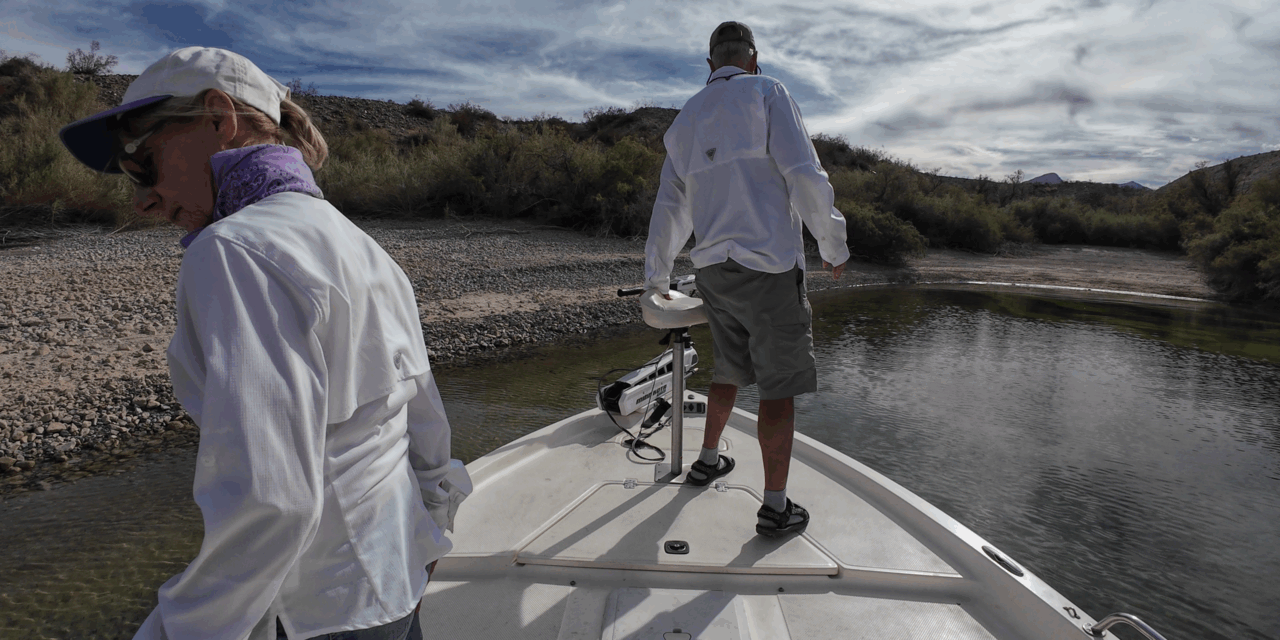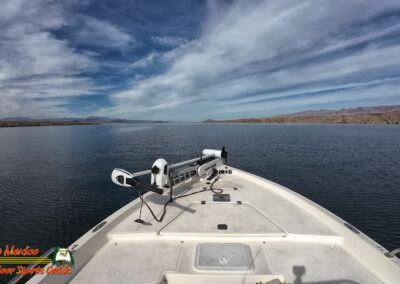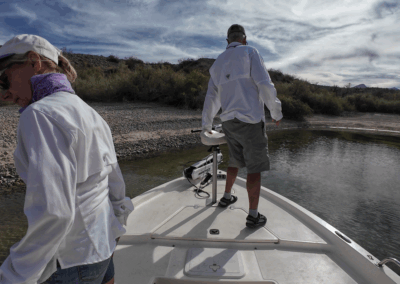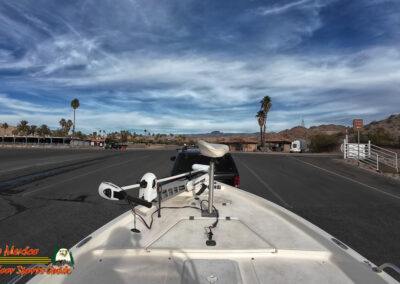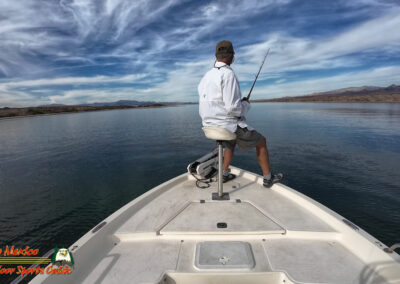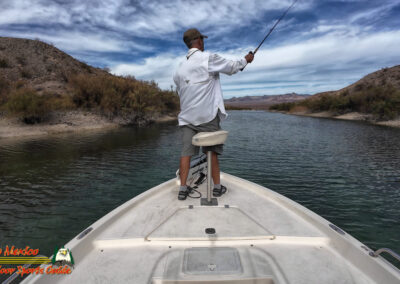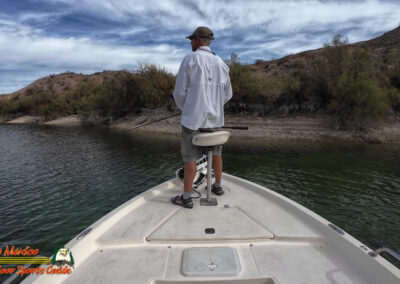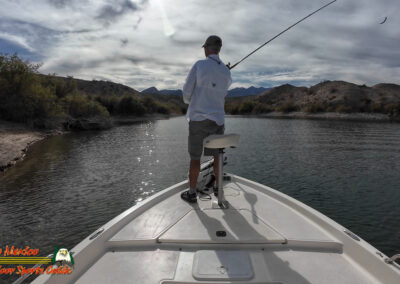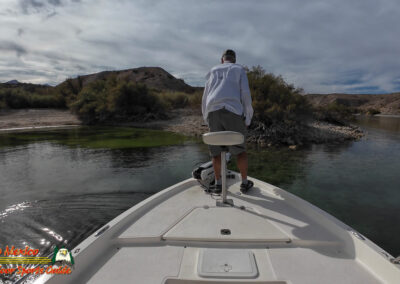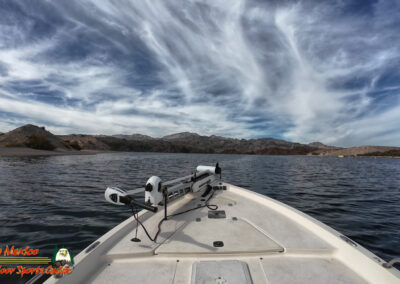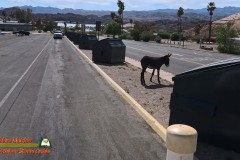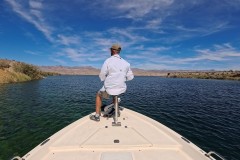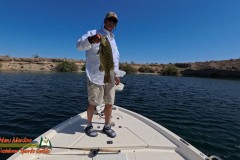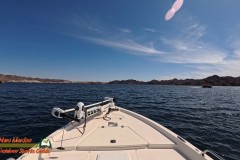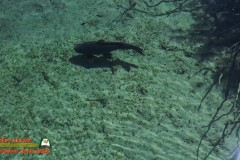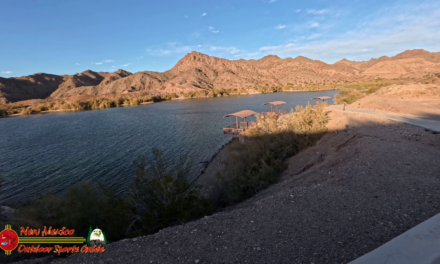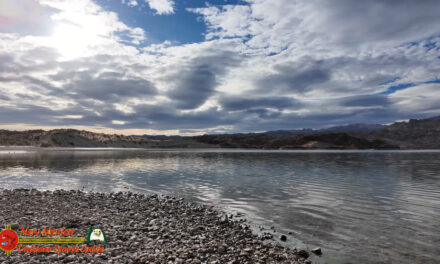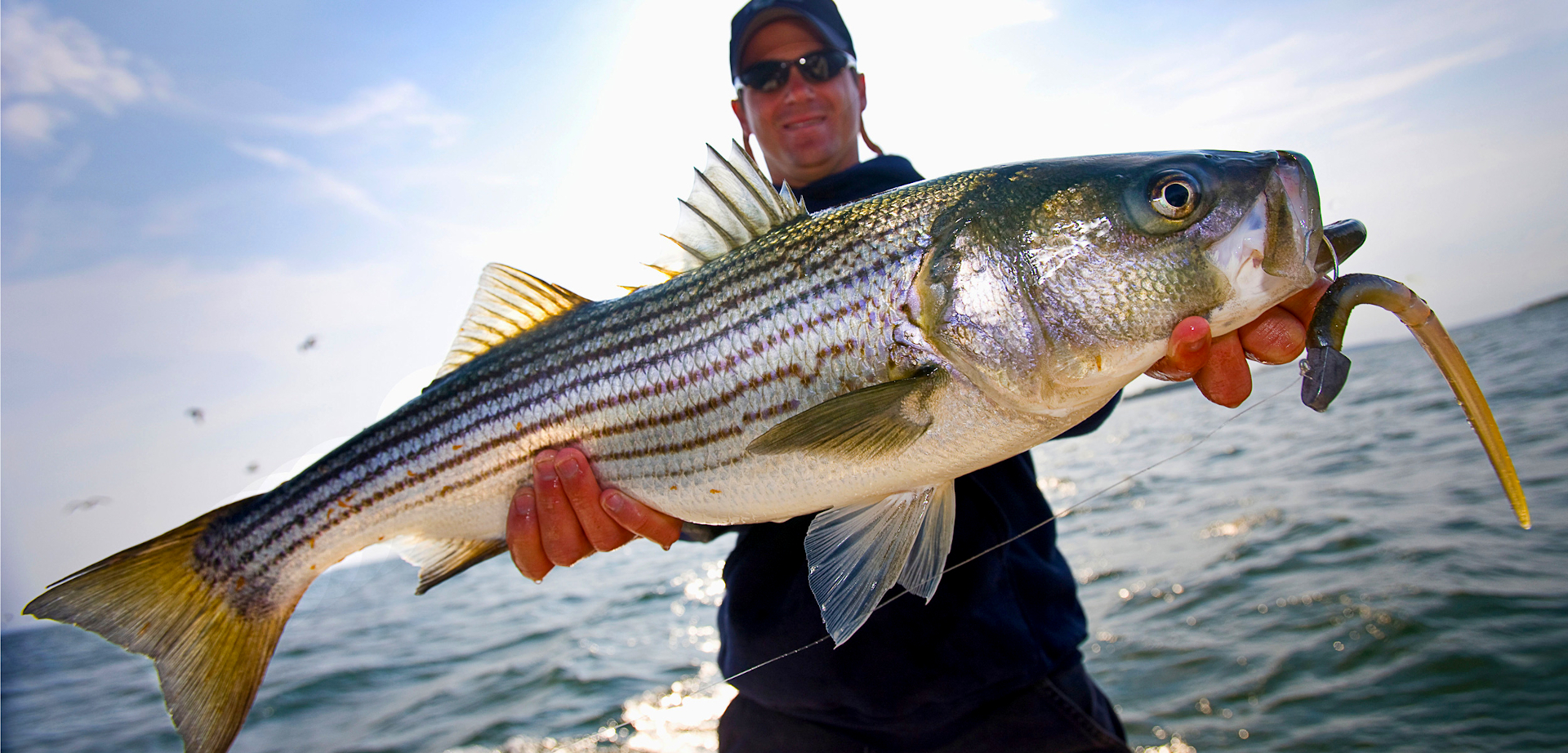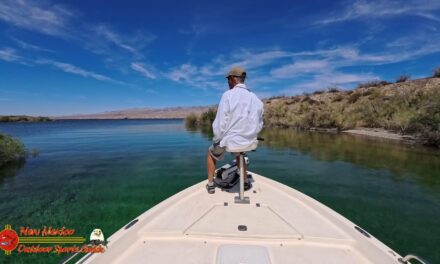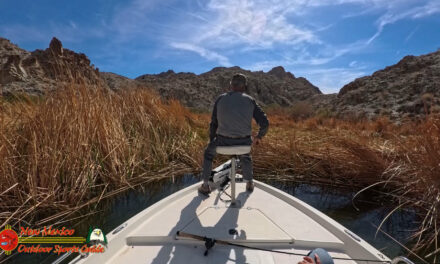There’s a rhythm to life on the Colorado River fed Lake Mohave that you learn to respect when you’ve been coming here as long as Paulette and I have. The desert waters that fill this magnificent reservoir don’t play by the same rules as those bass-rich Texas lakes I fished for decades, or the high-country streams I cast into during our years at Casa Oso. This is different water—ancient, carved through stone by the mighty Colorado River, held in place by Hoover Dam to the north and Davis Dam to the south, creating sixty-seven miles of fishing paradise that straddles the Arizona-Nevada border.
By mid-November, the clock is ticking. Our window for comfortable days on the water is closing fast. Usually around Thanksgiving, the temperatures drop enough that even a Kansas ranch kid turned octogenarian like me thinks twice about spending hours on an open boat. But when I checked the forecast and saw mid-80s with light winds predicted, I knew we had to make it happen. Tomorrow was going to be our day.
Paulette doesn’t need much convincing. After forty-plus years of marriage, I know that look in her eyes when the weather report promises a perfect day on the water. She’s always chomping at the bit to get out there, and honestly, so am I. There’s something about being on the Colorado River fed Lake Mohave that settles into your bones—the crystal-clear water, the desert hills rising up like ancient sentinels, the way the light plays off the surface when conditions are just right.
But first, there was work to do. Our twenty-foot Key West center console had been sitting in the boat barn all summer while we were up in Santa Fe enjoying the cooler mountain air and exploring the trails around our home. That’s the beauty and the challenge of our split-year lifestyle—we get the best of both worlds, but it means equipment sits idle for months at a time.
I spent the afternoon in the barn getting everything ready. The trolling motor battery needed charging, as did the outboard battery. Can’t take chances with batteries out here in the Mojave Desert—if something fails when you’re miles up the lake, it’s not like calling for a tow truck on some Kansas back road. The Colorado River fed Lake Mohave is spectacular, but it demands respect and preparation.
I checked the oil in the outboard, inspected the fuel lines, made sure the safety equipment was in order. At my age, I’ve learned that an ounce of prevention is worth a pound of cure, especially when it comes to boating. Growing up on those ranches in the Flint Hills, my father taught me to maintain equipment like your life depended on it—because sometimes it does. That lesson has served me well whether I was flying a twin-engine Beechcraft Baron to construction sites, running a fishing magazine, or now, preparing for an afternoon on one of the Southwest’s most beautiful bodies of water.
Morning Preparations and Team Effort
The next morning arrived with promise written across the sky. High cirrus clouds stretched in wispy formations above the desert, the kind of clouds that make for spectacular photography and video work. I’ve shot hundreds of hours of footage across Arizona, Utah, Colorado, and New Mexico for the New Mexico Outdoor Sports Guide, and I’ve learned to read the light. These conditions were perfect—enough cloud cover to add drama without blocking the sun, and the wind forecast remained favorable.
After lunch, Paulette and I fell into our well-practiced routine. Getting a boat from the barn to the water is a team effort, and after all these years, we’ve got it down to a science. She handles certain tasks, I handle others, and together we make it happen. The Cherokee gets hooked to the trailer, supplies get loaded—water, snacks, first aid kit, extra rope, the action camera, my Lowrance graph. Living through as many adventures as we have teaches you not to cut corners on preparation.
The drive from Casa Codorniz down to Katherine Landing Marina is short, maybe ten minutes of winding desert road. Katherine Landing sits on the Arizona side of the Colorado River fed Lake Mohave, tucked into a natural harbor that provides excellent protection from the wind. The marina has been here since the lake was formed in 1953, serving as the primary launch point for thousands of boaters over the decades. It’s well-maintained, with good ramps and plenty of parking for trucks and trailers.
Launch and Setup
While Paulette took the Cherokee and trailer to park in the lot, I stayed with the Key West center console to get her water-ready. Center console boats are ideal for this kind of fishing and exploring—the open deck gives you 360-degree access, perfect for working the shorelines and washes that make the Colorado River fed Lake Mohave such productive fishing water. The Key West is a solid, well-built craft that handles the occasional chop with ease and provides a stable platform for both fishing and photography.
I mounted the Lowrance graph on its bracket—modern fish finders are technological marvels compared to the crude flasher depth sounders I used decades ago. This unit shows depth, structure, fish, water temperature, GPS coordinates, and can even map the underwater contours as you run. I secured the action camera in position to capture our journey, then plugged in the trolling motor and tested it. The electric motor whirred to life perfectly—smooth, quiet, powerful. Electric trolling motors have revolutionized how we fish these desert lakes. They’re silent, efficient, and allow you to work a shoreline slowly without the noise and smell of a gas motor.
I saw Paulette walking out on the dock, and I eased the Key West in to pick her up. She stepped aboard with the practiced balance of someone who’s spent countless hours on boats, and we were off. I brought the outboard up to speed and pointed the bow north, leaving Katherine Landing Marina behind us as we entered the main channel of the Colorado River fed Lake Mohave.
The Journey North
Running up the lake at 26 mph, the Key West cut through the water smoothly. The ride takes about twenty-five minutes to reach some of our favorite coves, and every minute of it is spectacular. The eastern shore rises in dramatic formations of ancient stone, layers of geological history exposed by the Colorado River’s patient carving over millions of years. To the west, Spirit Mountain dominates the skyline—a sacred peak to several Native American tribes, including the Mojave, Chemehuevi, and Hualapai people. At 5,639 feet, it rises as a reminder that this desert landscape has been home to humans for thousands of years before Davis Dam backed up the Colorado River to create this reservoir.
The Mojave Desert vegetation dots the hillsides in scattered patterns—creosote bush, brittlebush, various species of cactus including barrel cactus and prickly pear. It’s a harsh environment, but it’s also starkly beautiful in its own right. Having grown up in the tall grass prairies of Kansas, I’ve come to deeply appreciate how different ecosystems express their character. The Flint Hills were all about grass and rolling hills and big sky. The mountains around Angel Fire offered pine forests and alpine meadows. Here, the Mojave Desert presents a landscape of survival and adaptation, where every plant has learned to thrive on minimal water.
Finding Our Spot
We approached one of our favorite coves and immediately spotted a couple with their wave runner already anchored up, enjoying the afternoon. That’s the beauty of the Colorado River fed Lake Mohave—there’s enough water and enough coves that you never have to crowd anyone. We waved to them and turned west, crossing the lake toward another of our go-to fishing spots.
This is the part of boating that requires local knowledge and attention. The Colorado River fed Lake Mohave can be deceptive. That crystal-clear water is both a blessing and a danger—you can see bottom in many places, which is wonderful for spotting fish, but you can also spot rocks and underwater hazards that would ruin your day in a hurry. The Lowrance graph helps, constantly reading the depth beneath us, but there’s no substitute for keeping your eyes open and remembering where the trouble spots are.
We arrived at the second cove to find it completely to ourselves—exactly what we were hoping for. I started the action camera rolling to capture the afternoon, then dropped the trolling motor and switched it on. The electric motor hummed quietly as I began working us along the shoreline, moving slowly enough to really scout the water.
The Art of Desert Lake Fishing
Fishing the Colorado River fed Lake Mohave is different from fishing those bass lakes I knew so well in Texas and Louisiana. The water here is startlingly clear—you can often see twenty or thirty feet down in good light. That clarity means the fish can see you too, so stealth matters. The trolling motor is essential for this kind of work. Where a gas outboard would spook every fish within a hundred yards, the electric motor lets you ghost along the shoreline like a whisper.
We were looking for smallmouth bass, primarily. Lake Mohave is famous for its smallmouth fishing—fish that move into the coves and along rocky shorelines, ambushing prey that ventures too close. The lake also holds largemouth bass, striped bass, channel catfish, and even rainbow trout in the deeper, cooler sections. But on an afternoon like this, working shallow coves with the trolling motor, we were hunting smallmouth.
The high cirrus clouds broke up the sky perfectly, allowing enough blue to show through while providing dramatic contrast for photographs and video. The light hit the water at angles that highlighted every stone and sand patch below. The cove was fairly large, bordered by low desert hills covered in that characteristic Mojave Desert vegetation. The contrast between the deep blue-green of the Colorado River fed Lake Mohave water and the browns and tans of the surrounding desert never gets old.
Taking Our Time
We spent about an hour working that first cove, the trolling motor whirring steadily as we ducked into several washes along the route. Washes are dry creek beds that only run water during the occasional desert rainstorm, but they create breaks in the shoreline that concentrate fish. Every wash is worth checking carefully.
We didn’t mark any fish on that particular pass, but that wasn’t really the point. Sure, catching fish is always the goal, but at our age, Paulette and I have learned that being on the water, experiencing the beauty of places like the Colorado River fed Lake Mohave, watching the light change and the shadows move across ancient stone—that’s the real prize. The fish are a bonus.
The Key West center console proved its worth as we worked along the shoreline. The open deck meant I could move from the console to the bow to either side without obstacles. The trolling motor mounted on the bow gave me precise control, letting me hold position against any breeze or current, letting me duck in close to structure, letting me back away when we needed to reposition.
Multiple Coves, Multiple Chances
After thoroughly working that first large cove, we motored on to three or four more smaller coves on our way back south toward Katherine Landing Marina. Each cove has its own character—some have rocky points, some have gravel beaches, some have underwater boulder fields that show up clearly in the transparent water of the Colorado River fed Lake Mohave. We worked each one methodically, the trolling motor doing its job, the action camera capturing the journey, Paulette and I falling into the comfortable silence of people who’ve shared countless hours on the water together.
The beauty of the Mojave Desert was on full display. Chaparral and various cactus species dotted the hillsides. The afternoon sun brought out the colors in the stone—reds and browns and tans, the oxidized minerals in the rock creating an artist’s palette of earth tones. This is landscape photography at its finest, the kind of scenery that I’ve devoted my retirement years to documenting for the New Mexico Outdoor Sports Guide and my own archives.
The Return Journey
As the afternoon progressed, we kept one eye on the time. One of the cardinal rules of boating, especially for folks our age, is to always plan your return with plenty of margin. We make it a point to get back to Katherine Landing Marina with enough time to load the boat on the trailer, secure everything properly, make the ten-minute drive home, and get the boat back in the barn with the Cherokee parked beside it well before dark.
This isn’t just about convenience—it’s about safety. Living in the desert means being mindful of our rattlesnake neighbors. Those diamondbacks and Mojave greens don’t keep business hours, and they’re most active around dawn and dusk. Working around a boat and trailer in the dark, in country where rattlesnakes hunt, is a risk we simply won’t take. Call it wisdom earned over eight decades of living, but I’ve learned to respect the wildlife and plan accordingly.
The run back south down the Colorado River fed Lake Mohave was just as beautiful as the run north had been. The sun was lower now, painting everything in that golden light that photographers dream about. Spirit Mountain stood dark against the western sky. The water remained smooth, the Key West eating up the miles effortlessly.
Safe Harbor
We arrived back at Katherine Landing Marina right on schedule. I brought the Key West in slowly, mindful of other boats and the wake restrictions near the docks. Paulette hopped off to get the Cherokee and trailer while I secured the boat and started the process of buttoning everything down.
This is where having a routine really pays off. The Lowrance graph comes off its mount and goes in its protective case. The action camera gets powered down and stored. I check that nothing is loose, that everything is secured for the trip home. The trolling motor gets tilted up and locked in position.
When Paulette returns with the Cherokee and trailer, we work together to load the Key West center console. Back it down the ramp, position the trailer, ease the boat on, secure it with straps and chains, winch it tight. It’s a dance we’ve done hundreds of times, and we execute it efficiently even now, in our eighties, working as the team we’ve always been.
Reflections
As we made that ten-minute drive from Katherine Landing back to Casa Codorniz, the boat trailing behind us, I found myself reflecting on how fortunate we are. Growing up on those Kansas ranches, I could never have imagined the life I’d lead—flying planes, running businesses, publishing magazines, building websites, photographing wildlife across the Southwest. And through it all, having Paulette beside me, sharing the adventures.
The Colorado River fed Lake Mohave has become one of our special places. It’s different from the high-country lakes near Angel Fire, different from the bass lakes of Texas, different from Eagle Nest Lake that we looked down on from Casa Oso for seventeen years. But it has its own magic, its own draw. The crystal-clear water flowing down from Hoover Dam, channeled by the Colorado River, held in place by Davis Dam—it’s a testament to human engineering creating recreational opportunities in one of the most challenging environments in North America.
Back at the barn, we unloaded our gear and got the Key West secured for its next outing. The batteries would need charging again before we headed out next time. The outboard would need checking. But that’s tomorrow’s work. Today was about being on the water, exploring the coves, enjoying the spectacular scenery, and making another memory together.
Until Next Time
As darkness settled over the Mojave Desert and we retreated to the comfort of Casa Codorniz, I couldn’t help but smile. We’d gotten in one more afternoon on the Colorado River fed Lake Mohave before the chilly weather arrives. The forecast might bring cooler temperatures soon, maybe even keep us off the water until things warm up again. But we’d made the most of the opportunity.
That’s the lesson I learned on those Kansas ranches seventy-plus years ago—when the weather’s right and the opportunity presents itself, you take it. You don’t wait, you don’t procrastinate, you don’t make excuses. You hook up the boat, you make the short drive to the marina, you launch, and you go.
The Colorado River fed Lake Mohave will be here when we return. The coves will wait for us. The smallmouth bass will still be hunting those rocky shorelines. And when the weather warms again, when the forecast shows those mid-80s temperatures and light winds, we’ll charge up the batteries, check the oil, hook the Cherokee to the trailer, and do it all over again.
Because that’s what you do when you’re lucky enough to call this magnificent desert landscape home for part of the year. You respect it, you prepare properly, you practice safe boating, and you never take for granted the gift of another afternoon on the water.
Another great day on Lake Mohave, well done indeed.
About the Author spent his early years working his family’s cattle ranch in Kansas before pursuing a career in wildlife photography. Now retired and living in Santa Fe, New Mexico but wintering at Lake Mohave, Arizona he dedicates his time to documenting the wilderness and wildlife of the American Southwest, with a particular focus on the Mountains and Deserts of Arizona, Utah, Colorado and New Mexico. His work has been featured in New Mexico Outdoor Sports Guide blog and hundreds of NMOSG YouTube video publications, the Texas
SportsGuide and Black Bass magazines.

